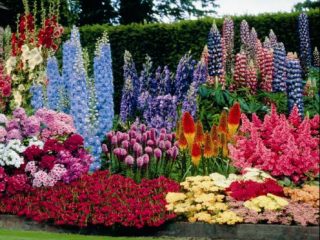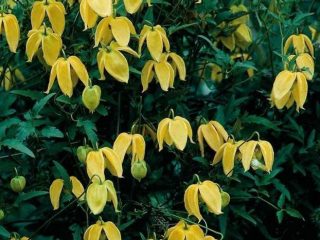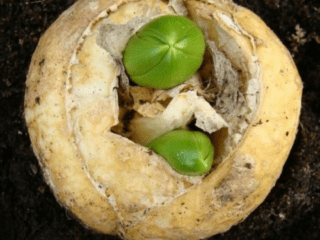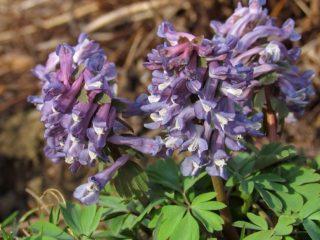Content
Peonies are often part of landscape compositions. Like roses, they gained popularity thanks to their large flowers, the colors of which can be quite varied, and the shape is unusual. Peony Neon is a plant that is easy to remember. And not only because of the consonant name, but also because of the bright petals, arranged in a bizarre manner.
How the variety appeared
A huge number of nurseries are engaged in breeding peonies. They are in Holland, China, Japan, USA, Russia and other countries. The American company Nicholls is behind the discovery of this variety. Peony Neon was developed by scientists in 1941 and is considered a Western classic.
The plant gained popularity only 30 years later, when the number of gardeners began to grow. In the 70s, the Neon peony migrated to Europe, and from there it spread across the globe. Currently, bushes are of interest to florists and experimenters.
Description of the peony variety Neon with photo
The plant has compact dimensions, rarely exceeding 100 cm in height. But there are “taller” specimens that grow up to 140 cm. To achieve such results, Neon peony must be grown in ideal conditions.The stems are thick, the leaves are green and have an openwork shape.

During the budding period, the shrub forms large (up to 16 cm) buds that open simultaneously
There are small stamens at the core of the inflorescence, but they can only be seen close up.
Timing and flowering period
The variety has a flowering period similar to other peonies. Neon increases its decorative mass in early June. The process takes several days. Flowering duration ranges from 1 to 3 weeks. It can be affected by lighting, precipitation, and soil composition.
Advantages and disadvantages
Peony Neon has a good immune system, so diseases and insects rarely harm plantings.

The bright plant is widely used for decorative purposes.
Pros:
- compactness;
- noticeable aroma;
- resistance to short-term drought;
- winter hardiness;
- interesting shape and large size of buds.
Minuses:
- Peony does not grow on acidic substrates.
How to plant
Planting work is planned for late summer - early September. The most important thing is not so much the time as the place where Neon will grow. The variety requires light areas with average humidity.
The best choice for planting would be loam. When mass planting, a distance of 1 m is maintained between Neon peonies. Despite its compactness, the crop grows quickly, and within a year it will need a lot of free space.
Before planting, the soil is fertilized with organic complexes - peat, rotted manure.You need to be careful with the dosage, as fertilizing acidifies the soil. In a month they will be completely assimilated, and you can start digging a hole.
Care instructions
Peony Neon requires rare but abundant watering. The amount of moisture is increased during flowering, as well as before the arrival of winter. Maintenance of the bush requires up to three buckets of water weekly. Much depends on weather conditions. For example, in cloudy weather, planned moisture can lead to rotting of the underground part of the peony.
For the first three years, the Neon variety is fed surface-fed. When the roots have adapted sufficiently, mineral fertilizers begin to be applied to the soil. Experts recommend using complex store-bought mixtures marked “For peonies.”

Feed flowers three times a season
Preparing for winter
Peony Neon does not need shelter. In the first year of planting, they are insulated with mulch; in the future, this procedure will also be optional. The plant tolerates temperatures down to -40 degrees and is suitable for growing in northern regions.
Reproduction methods
Perennials are grown using:
- stem or root cuttings;
- by division method.
To propagate Neon peony from stem cuttings, it takes at least two years, and further growth will take another five years. In this case, the features of the parent plant are often lost, which has made the method unpopular in gardening practice.
Root cuttings are a more effective method. With proper agricultural technology, the survival rate will be more than 60%. Necessary: dig up the bush and cut off part of the roots with three renewal buds.To prevent the plant from getting sick, the cut is sprinkled with coal. After this, the Neon peony is planted in a pot with loose soil, grown for two years and then transplanted to the country.
Dividing the rhizome is the best solution to propagate Neon peonies. The labor intensity and time spent on cultivation are minimal when compared with other methods. Division allows you to preserve all varietal characteristics.
To propagate Neon peony, the roots of the mother plant are washed in water. After drying, it is necessary to separate a bunch of roots with three renewal buds and the same number of tubers. The cuttings are placed in soil prepared in advance by the gardener, and the plant’s reaction is awaited.

In suitable conditions, peonies will bloom within a year.
Disease and pest control
One of the troubles that gardeners face is the reduction in the number of buds and the appearance of spots on the leaves - yellow, gray, brown. As well as pads with spores on the inside of the shoots.
The reason for the weakening is the infection of the bushes with diseases:
- botrytis;
- ring mosaic;
- verticillium.
Plants can be saved. To do this, if the symptoms of the disease have appeared recently, the Neon peony is sprayed with a soap solution. In cases where the infection progresses for a long time, folk remedies are ineffective. The use of fungicides is necessary.
Pests also cause trouble. Moreover, the symptoms remain the same - curling of leaves, wilting and cessation of development. If there is a massive attack by insects, the Neon peony stops forming buds.
The main pest is the ant.Its attention is attracted by the sweet smell, the parasite reaches the flowers and begins to suck out the juice. Ants often carry aphids, which lead to the development of many diseases.
It is difficult to remove the pest. If all the bushes are affected, you will have to get rid of them. If the gardener feels that the plants can still be saved, the shoots are sprayed with Iskra, Fitoverm or Biotlin.
Application in design
Neon peonies are often planted in a group with other garden plants. The variety is universal and suitable for planting with any crops.

You can make bushes an accent or background

Designers emphasize that conifers are excellent neighbors

Peonies are often used as a tapeworm
Flowers are planted in open meadows, lawns and next to the fence.
Conclusion
Peony Neon is a variety bred in the middle of the last century. It gained popularity as an ornamental plant 30 years later. This perennial is considered a classic. It requires minimal care, and in the summer it forms large and fragrant flowers, which, unfortunately, can attract not only the owner, but also insects (ants, aphids). Pests are extremely dangerous, and action must be taken quickly at the first sign of their appearance.
Reviews from flower growers about peony Neon








